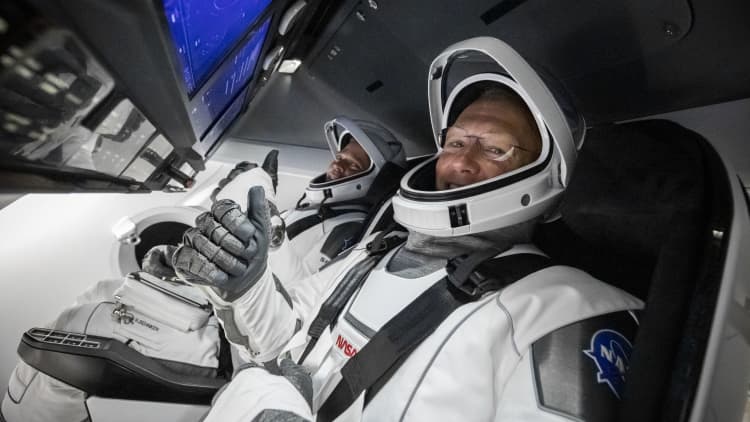SpaceX safely returned NASA astronauts Bob Behnken and Doug Hurley to Earth on Sunday afternoon, concluding a two month test that was historic for both the company and agency.
The company's Crew Dragon spacecraft splashed down in the Gulf of Mexico near Pensacola, Florida. The astronauts were recovered by a SpaceX ship shortly after, with Behnken and Hurley waving and giving a thumbs on NASA's webcast of the event..
Known as Demo-2, the mission represented the first time Elon Musk's company has sent astronauts to space — making SpaceX the first private company to send people to orbit, a feat only previously achieved by government superpowers. For NASA it marks the return of the United States' capability to launch its own astronauts, which the country has lacked since the Space Shuttle program ended nearly a decade ago. NASA intends to launch its astronauts on SpaceX spacecraft every few months going forward, paying an estimated $55 million per seat.
"It's really establishing the business model for the future," NASA Administrator Jim Bridenstine said during the agency's webcast on Sunday. "It's the next era in human spaceflight, where NASA gets to be the customer."

The Demo-2 mission marks the final test after SpaceX has spent years developing the Crew Dragon capsule. NASA has awarded SpaceX with $3.1 billion to develop the spacecraft, as well as launch six operational missions. The agency also awarded Boeing with contracts worth $4.8 billion to developing a spacecraft called Starliner, although that competing capsule remains in development due to a failed flight test last December.
President Donald Trump tweeted his congratulations shortly after the capsule splashed down.
NASA expects to spent about six weeks reviewing the data from Demo-2 before it moves forward with the first operational mission, planned for late September.
Recovery after splashdown
Endeavour endured temperatures as high as 3,500 degrees Fahrenheit during the intense reentry through the Earth's atmosphere — although inside Crew Dragon temperatures did not reach more than 85 degrees, thanks to the spacecraft's dense heat shield.
The spacecraft splashed down gently in the ocean under its set of parachutes. Notably, Demo-2 marks the first splashdown in 45 years for NASA astronauts, as well as the first splashdown of a crew spacecraft in the Gulf of Mexico.
It took just about an hour and a half from splashdown until Hurley and Behnken were out of the capsule.
Shortly after splashdown a set of small boats went out to the capsule, securing it for recovery. One of the boats retrieved the parachutes from the water, while the other checked the exterior of Crew Dragon for any potentially dangerous leaks. Then SpaceX recovery ship GO Navigator used a crane to lift the spacecraft out of the water and on to its deck. GO Navigator has a support crew of about 40 NASA and SpaceX personnel onboard, each with specific roles during recovery.
Behnken and Hurley stayed seated during this process, with Endeavour's hatch closed. After they get out of the spacecraft, a helicopter carried Behnken and Hurley back to shore, taking off from the helipad on the ship's upper deck.
What they did
Behnken and Hurley launched atop a SpaceX Falcon 9 rocket on May 30, with the Crew Dragon spacecraft reaching the International Space Station the next day. The pair spent 63 days at the space station, where they tested out the SpaceX capsule's systems and features. Behnken and Hurley dubbed the spacecraft "Endeavour" — a name shared by the Space Shuttle orbiter, which both astronauts had flown on before, as well as the command module of the Apollo 15 mission.
Part of the testing of Crew Dragon while docked with the space station was a habitability test. That was to ensure four astronauts can perform necessary tasks when they are all inside the spacecraft.
Endeavour departed the space station on Saturday evening while in orbit above South Africa.
Next mission in late September
Assuming the data reviews from Demo-2 do not show up any major issues, NASA plans to launch the SpaceX Crew-1 mission in late September. That will be the first operational mission of SpaceX's Crew Dragon and will carry NASA astronauts Mike Hopkins, Victor Glover, Shannon Walker and JAXA astronaut Soichi Noguchi, the first four person crew.
Subscribe to CNBC PRO for exclusive insights and analysis, and live business day programming from around the world.


